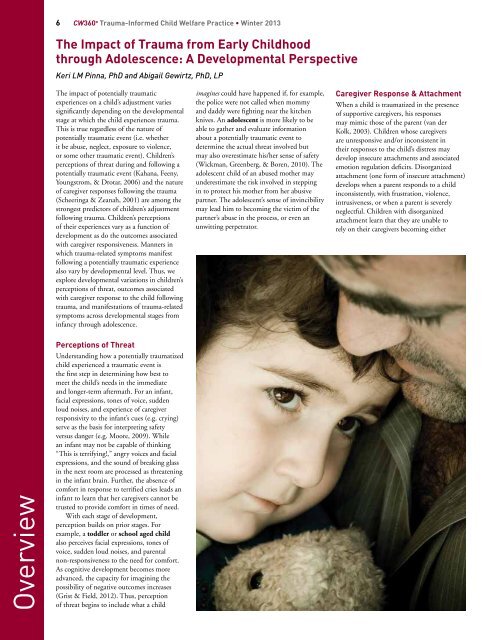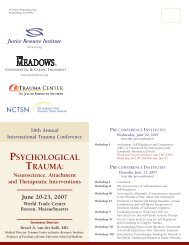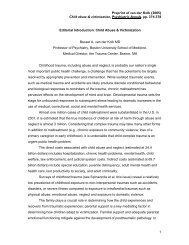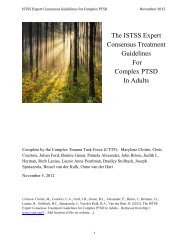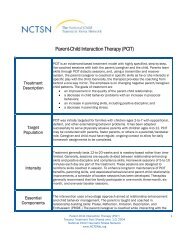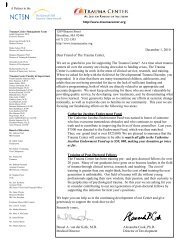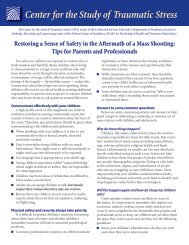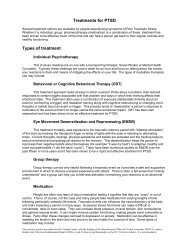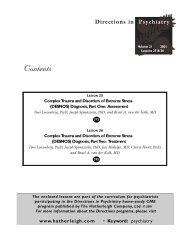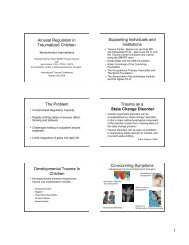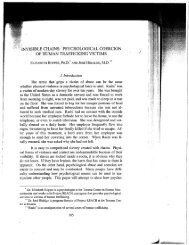in Child Welfare - The Trauma Center
in Child Welfare - The Trauma Center
in Child Welfare - The Trauma Center
You also want an ePaper? Increase the reach of your titles
YUMPU automatically turns print PDFs into web optimized ePapers that Google loves.
6 CW360 o <strong>Trauma</strong>-Informed <strong>Child</strong> <strong>Welfare</strong> Practice • W<strong>in</strong>ter 2013<strong>The</strong> Impact of <strong>Trauma</strong> from Early <strong>Child</strong>hoodthrough Adolescence: A Developmental PerspectiveKeri LM P<strong>in</strong>na, PhD and Abigail Gewirtz, PhD, LP<strong>The</strong> impact of potentially traumaticexperiences on a child’s adjustment variessignificantly depend<strong>in</strong>g on the developmentalstage at which the child experiences trauma.This is true regardless of the nature ofpotentially traumatic event (i.e. whetherit be abuse, neglect, exposure to violence,or some other traumatic event). <strong>Child</strong>ren’sperceptions of threat dur<strong>in</strong>g and follow<strong>in</strong>g apotentially traumatic event (Kahana, Feeny,Youngstrom, & Drotar, 2006) and the natureof caregiver responses follow<strong>in</strong>g the trauma(Scheer<strong>in</strong>ga & Zeanah, 2001) are among thestrongest predictors of children’s adjustmentfollow<strong>in</strong>g trauma. <strong>Child</strong>ren’s perceptionsof their experiences vary as a function ofdevelopment as do the outcomes associatedwith caregiver responsiveness. Manners <strong>in</strong>which trauma-related symptoms manifestfollow<strong>in</strong>g a potentially traumatic experiencealso vary by developmental level. Thus, weexplore developmental variations <strong>in</strong> children’sperceptions of threat, outcomes associatedwith caregiver response to the child follow<strong>in</strong>gtrauma, and manifestations of trauma-relatedsymptoms across developmental stages from<strong>in</strong>fancy through adolescence.imag<strong>in</strong>es could have happened if, for example,the police were not called when mommyand daddy were fight<strong>in</strong>g near the kitchenknives. An adolescent is more likely to beable to gather and evaluate <strong>in</strong>formationabout a potentially traumatic event todeterm<strong>in</strong>e the actual threat <strong>in</strong>volved butmay also overestimate his/her sense of safety(Wickman, Greenberg, & Boren, 2010). <strong>The</strong>adolescent child of an abused mother mayunderestimate the risk <strong>in</strong>volved <strong>in</strong> stepp<strong>in</strong>g<strong>in</strong> to protect his mother from her abusivepartner. <strong>The</strong> adolescent’s sense of <strong>in</strong>v<strong>in</strong>cibilitymay lead him to becom<strong>in</strong>g the victim of thepartner’s abuse <strong>in</strong> the process, or even anunwitt<strong>in</strong>g perpetrator.Caregiver Response & AttachmentWhen a child is traumatized <strong>in</strong> the presenceof supportive caregivers, his responsesmay mimic those of the parent (van derKolk, 2003). <strong>Child</strong>ren whose caregiversare unresponsive and/or <strong>in</strong>consistent <strong>in</strong>their responses to the child’s distress maydevelop <strong>in</strong>secure attachments and associatedemotion regulation deficits. Disorganizedattachment (one form of <strong>in</strong>secure attachment)develops when a parent responds to a child<strong>in</strong>consistently, with frustration, violence,<strong>in</strong>trusiveness, or when a parent is severelyneglectful. <strong>Child</strong>ren with disorganizedattachment learn that they are unable torely on their caregivers becom<strong>in</strong>g eitherOverviewPerceptions of ThreatUnderstand<strong>in</strong>g how a potentially traumatizedchild experienced a traumatic event isthe first step <strong>in</strong> determ<strong>in</strong><strong>in</strong>g how best tomeet the child’s needs <strong>in</strong> the immediateand longer-term aftermath. For an <strong>in</strong>fant,facial expressions, tones of voice, suddenloud noises, and experience of caregiverresponsivity to the <strong>in</strong>fant’s cues (e.g. cry<strong>in</strong>g)serve as the basis for <strong>in</strong>terpret<strong>in</strong>g safetyversus danger (e.g. Moore, 2009). Whilean <strong>in</strong>fant may not be capable of th<strong>in</strong>k<strong>in</strong>g“This is terrify<strong>in</strong>g!,” angry voices and facialexpressions, and the sound of break<strong>in</strong>g glass<strong>in</strong> the next room are processed as threaten<strong>in</strong>g<strong>in</strong> the <strong>in</strong>fant bra<strong>in</strong>. Further, the absence ofcomfort <strong>in</strong> response to terrified cries leads an<strong>in</strong>fant to learn that her caregivers cannot betrusted to provide comfort <strong>in</strong> times of need.With each stage of development,perception builds on prior stages. Forexample, a toddler or school aged childalso perceives facial expressions, tones ofvoice, sudden loud noises, and parentalnon-responsiveness to the need for comfort.As cognitive development becomes moreadvanced, the capacity for imag<strong>in</strong><strong>in</strong>g thepossibility of negative outcomes <strong>in</strong>creases(Grist & Field, 2012). Thus, perceptionof threat beg<strong>in</strong>s to <strong>in</strong>clude what a child


